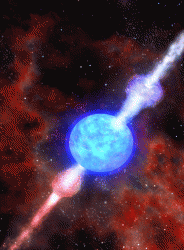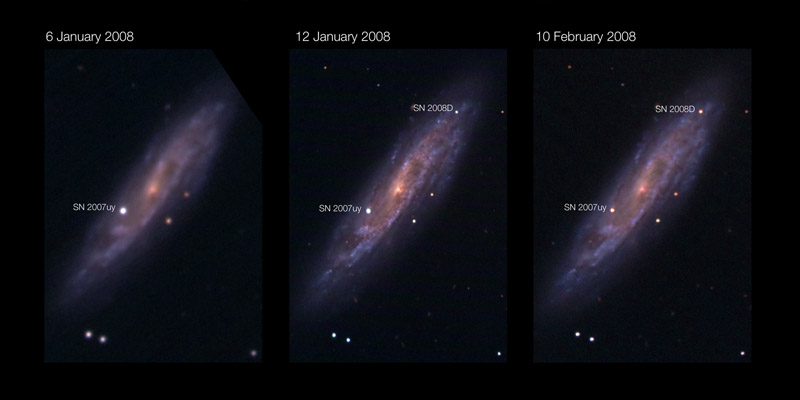[/caption]
Just when we thought we were beginning to understand what supernovae and gamma ray bursts were all about. Astronomers have just uncovered the true nature of what they thought was a regular supernova observed in January. At the time, it looked like a supernova emitting a 5-minute long burst of X-rays. But these X-rays were of a lower energy (known as “soft” X-rays) than expected leading some to believe this was a normal emission from a supernova explosion that was being observed during detonation (astronomers don’t usually get the chance to observe a star as it explodes and usually have to make do with analysing the supernova remnant). However, it is now believed this strange supernova event may have been emissions from a dying star at an intermediate mass, neither producing a supernova nor a gamma ray burst, but a combination of both…
Orbiting above Earth on January 9th 2008, the NASA/STFC/ASI Swift telescope caught a rare glimpse of what seemed to be a “normal” supernova at the precise moment of detonation. This observation was completely by luck, as Swift was already observing a supernova remnant (SN 2007uy) in spiral galaxy NGC 2770 that had exploded the previous year (90 million light-years away near the Lynx constellation). Then, as Swift was retrieving data from the SN 2007uy remnant, SN 2008D blasted a 5-minute long burst of X-rays in the same galaxy making this the first supernova to be directly observed.
However, looks can be deceiving. Researchers from a host of institutions including Italian National Institute for Astrophysics (INAF), the Max-Planck Institute for Astrophysics (MPA) and the European Southern Observatory (ESO) have analysed the supernova data thoroughly and at first agreed with the original assessment that it was indeed “normal.”
“What made this event very interesting is that the X-ray signal was very weak and ‘soft’, very different from a gamma-ray burst and more in line with what is expected from a normal supernova.” – Paolo Mazzali, INAF’s Padova Observatory/MPA, research leader.

However, astronomers at the Asiago Observatory in Northern Italy had designated the event as a Type 1c supernova, more commonly associated with long-period gamma-ray bursts. Type 1c supernovae are generated by hydrogen-poor progenitor stars with helium-rich outer layers prior to exploding at the end of their lives. But SN 2008D generated soft X-rays more associated with smaller stellar explosions. Therefore SN 2008D was probably produced by a star that was massive at birth (approximately 30 solar masses), rapidly using up its hydrogen fuel in its short life until it was only 8-10 solar masses. At this point it exploded, probably creating a remnant black hole. This chain of thought has led Paolo Mazzali and his team to think SN 2008D was produced by an object of a mass at the boundary of a normal supernova and gamma-ray burst.
“Since the masses and energies involved are smaller than in every known gamma-ray burst related supernova, we think that the collapse of the star gave rise to a weak jet, and that the presence of the Helium layer made it even more difficult for the jet to remain collimated, so that when it emerged from the stellar surface the [X-ray] signal was weak.” – Massimo Della Valle, co-investigator.
Researcher and co-author Stefano Valenti points out that this discovery indicates that all black hole-producing supernovae have the potential to be gamma-ray burst progenitors. “The scenario we propose implies that gamma-ray burst-like inner engine activity exists in all supernovae that form a black hole,” he added.
Source: ESO


Hi Don: You’re right, there could be another interpretation of these results (and I must admit, the press release was a little sketchy). Out of interest, I may have the definition incorrect, but when is an SNR not an SN? What physical characteristic makes an SNR? As I understand, a remnant is quite literally that, what’s left over, I’m not certain about time scales after the SN event. Will be good to know if my definition is a little out 🙂
Cheers, Ian
Ah, so Paolo has his own press release now…
I must say, I am quite critical of their paper. While they present some nice spectra etc., they hardly discuss at all why they think the X-ray outburst is due to a waek jet and not the non-relativistic SN shock break-out, as claimed by Soderberg et al. (Nature). Several other prominent researchers also follow the shock break-out interpretation and have strongly criticized papers claiming XRO 080109 to be an actual X-ray flash.
Two little comments on Ian’s article itself: One does not speak of “supernova remnants until many years after an SN. SN 2007uy is far from being a remnant! Furthermore, while (see the name…) it’s clear SN 2007uy happened “the previous year”, one should point out that it was discovered on December 30!! If people had just waited two more days before looking at NGC 2770, we would know it as SN 2008A, and SN 2008D would be SN 2008E. SN 2007uy was also caught early on, so less than two weeks passed between the discovery of the two events.
Supernova typically take 1-3 weeks to reach MAXIMUM light, so after two weeks, this would still be considered a supernova event.
I don’t think there is an exact definition of when an event becomes a remnant – but it would be reasonable to draw the line when the spectral signature indicates the fusion reaction has shut down, or in many cases, when we can no longer observe the event in a broad enough em spectrum to tell.
Wow dude that is just like totally way cool. Good article.
JT
/www.iurlz.com/demtools
god damn i love science!
Mainstream astrophysics hasn’t quite caught on to what this event and other new evidence is telling us about the inner dynamics of stars – that is all stars have black holes at their center.
Black holes are not formed upon the death of the star – rather the exact opposite is true – the black hole is the first thing emerging upon the birth of the star. Do you see those counter spinning vortices in the graphic above? New observation reveal that inside stellar nurseries counter spinning vortices touch amidst the gases and dust. Where those vortices touch a black hole exists and it grows in size relative to the amount of matter and energy around it.
The star grows as its engine grows in a “balanced” feedback loop – exchanging energy/matter between the radiative component, that we eventually see and call the star, and the contractive black hole at the center. A super nova is when a very large star falls out of balance – and releases energy so as to emerge in a new order of stasis.
Hello, Ian, jerry,
I’m not working in the field of SNe, so I can’t give you a perfect definition. Typical Sne are powered by the radioactive decay of heavy elements which are produced by runaway neutron accretion (r process) during the initial explosion. This is mostly Nickel 56, followed by Cobalt 56 (which has a longer half-life).
Early supernovae spectra are characterized by broad emission components reflecting the high expansion speed (up to 10% light speed for GRB-associated broad-line Type Ic SNe [“hpyernovae”]). After a few months, the SNe enter the so-called nebular phase, which feature strong emission lines from forbidden transitions.
To my understanding, a SNR is what the expanding shell of the explosion is called at a time when all the radioactives (except for rare, long-lived isotopes like actinids) have decayed (thus no longer powering em emission), and the only emission comes from the shock-heating of the interstellar medium at the collision front. This transition typically happens after one or a few decades. SN 1987A is giving us the first glimpse of a newborn SNR. Things like Cassiopeia A, Tycho’s SNR and Kepler’s SNR are typical for this phase.
SNR slowly peter out, diffuse, and disappear after a few million years. There’s speculation that the the Local Interstellar Bubble the sun sits in is a ~ 2 million year old SNR, the brightest SN in human (pre-)history.
Hope that helps!
@Hunabku: Always fascinating how we mainstream scientists always turn out to be completeley stupid and just plain wrong in the long run, eh?
Hi Don! Thanks for your insight. That question was bothering me so I did some research and still dug up very little. It does make sense that an SNR should form a while after the event, rather than right after the SN. I’ve done several classes on supernovae (and even taught some basic astronomy lectures on the subject) and I wasn’t sure how long a supernova is classed as a supernova! Learn something new every day 😉
Best, Ian 😀
If its true that astronomers discovered a supernova hybrid that’s really cool. But even today so many theories still revolve around.
the light of the explosion affects a large area of that galaxy (or is it seen as such from here?). my question would be how come if the speed of light is fixed, explosion will extend such a vast area in such a short time?